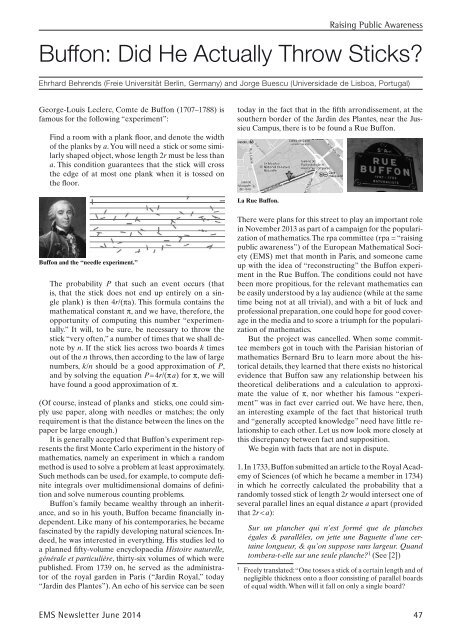1mZ2hsN
1mZ2hsN
1mZ2hsN
You also want an ePaper? Increase the reach of your titles
YUMPU automatically turns print PDFs into web optimized ePapers that Google loves.
Raising Public AwarenessBuffon: Did He Actually Throw Sticks?Ehrhard Behrends (Freie Universität Berlin, Germany) and Jorge Buescu (Universidade de Lisboa, Portugal)George-Louis Leclerc, Comte de Buffon (1707–1788) isfamous for the following “experiment”:Find a room with a plank floor, and denote the widthof the planks by a. You will need a stick or some similarlyshaped object, whose length 2r must be less thana. This condition guarantees that the stick will crossthe edge of at most one plank when it is tossed onthe floor.today in the fact that in the fifth arrondissement, at thesouthern border of the Jardin des Plantes, near the JussieuCampus, there is to be found a Rue Buffon.La Rue Buffon.Buffon and the “needle experiment.”The probability P that such an event occurs (thatis, that the stick does not end up entirely on a singleplank) is then 4r/(pa). This formula contains themathematical constant p, and we have, therefore, theopportunity of computing this number “experimentally.”It will, to be sure, be necessary to throw thestick “very often,” a number of times that we shall denoteby n. If the stick lies across two boards k timesout of the n throws, then according to the law of largenumbers, k/n should be a good approximation of P,and by solving the equation P = 4r/(p a) for p, we willhave found a good approximation of p.(Of course, instead of planks and sticks, one could simplyuse paper, along with needles or matches; the onlyrequirement is that the distance between the lines on thepaper be large enough.)It is generally accepted that Buffon’s experiment representsthe first Monte Carlo experiment in the history ofmathematics, namely an experiment in which a randommethod is used to solve a problem at least approximately.Such methods can be used, for example, to compute definiteintegrals over multidimensional domains of definitionand solve numerous counting problems.Buffon’s family became wealthy through an inheritance,and so in his youth, Buffon became financially independent.Like many of his contemporaries, he becamefascinated by the rapidly developing natural sciences. Indeed,he was interested in everything. His studies led toa planned fifty-volume encyclopaedia Histoire naturelle,générale et particulière, thirty-six volumes of which werepublished. From 1739 on, he served as the administratorof the royal garden in Paris (“Jardin Royal,” today“Jardin des Plantes”). An echo of his service can be seenThere were plans for this street to play an important rolein November 2013 as part of a campaign for the popularizationof mathematics. The rpa committee (rpa = “raisingpublic awareness”) of the European Mathematical Society(EMS) met that month in Paris, and someone cameup with the idea of “reconstructing” the Buffon experimentin the Rue Buffon. The conditions could not havebeen more propitious, for the relevant mathematics canbe easily understood by a lay audience (while at the sametime being not at all trivial), and with a bit of luck andprofessional preparation, one could hope for good coveragein the media and to score a triumph for the popularizationof mathematics.But the project was cancelled. When some committeemembers got in touch with the Parisian historian ofmathematics Bernard Bru to learn more about the historicaldetails, they learned that there exists no historicalevidence that Buffon saw any relationship between histheoretical deliberations and a calculation to approximatethe value of p, nor whether his famous “experiment”was in fact ever carried out. We have here, then,an interesting example of the fact that historical truthand “generally accepted knowledge” need have little relationshipto each other. Let us now look more closely atthis discrepancy between fact and supposition.We begin with facts that are not in dispute.1. In 1733, Buffon submitted an article to the Royal Academyof Sciences (of which he became a member in 1734)in which he correctly calculated the probability that arandomly tossed stick of length 2r would intersect one ofseveral parallel lines an equal distance a apart (providedthat 2r < a):Sur un plancher qui n’est formé que de plancheségales & parallèles, on jette une Baguette d’une certainelongueur, & qu’on suppose sans largeur. Quandtombera-t-elle sur une seule planche? 1 (See [2])1Freely translated: “One tosses a stick of a certain length and ofnegligible thickness onto a floor consisting of parallel boardsof equal width. When will it fall on only a single board?EMS Newsletter June 2014 47


